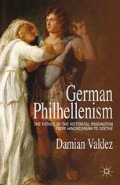Abstract
Iphigenie was written “from a study of Greek matters that was inadequate,” Goethe wrote to his friend Riemer in 1811. Had the study been more complete, he observed, the play would have remained unwritten.1 It was one of the few serious dramas mounted by the Weimar amateur theatre, writes Nicholas Boyle.2 The court theatre had burned down in 1774 with most of the professional actors moving to Gotha, a splendid baroque residential city. Figures from the Weimar court and the ducal family itself became the actors. The first performance of Goethe’s play took place at the house of the court gamekeeper Anton Hauptmann, on April 6, 1779, where a provisional stage had been set up. Knebel, after initially refusing, played the role of Thoas. Goethe himself played Orestes, and prince Constantin, brother of the duke, played Pylades, with Goethe’s friend Seidler as Arkas, Thoas’s messenger. Iphigenia was represented by the professional actress Corona Schröter, a platonic flame of Goethe’s. The spectator Luise von Göchhausen wrote to Goethe’s mother a few days later that he had “played his Orestes masterfully. His attire, like that of Pylades, was Greek und I have not seen him so beautiful in my life.”3 There were further performances that spring and summer at the Ettersburg residence on a hill overlooking Weimar and this time the duke himself played Pylades.
Access this chapter
Tax calculation will be finalised at checkout
Purchases are for personal use only
Preview
Unable to display preview. Download preview PDF.
Notes
Sybille Schönborn, “Vom Geschlechterkampf zum symbolischen Geschlechtertausch: Goethes Arbeit am antiken Mythos am Beispiel der Iphigenie auf Tauris,” in Goethes Rückblick auf die Antike, ed. Bernd Witte and Mauro Ponzi (Berlin: Erich Schmidt, 1999), 83.
Emil Staiger, Goethe 1749–1786 (Zürich: Atlantis, 1957), 357. 11.
Humphrey Trevelyan, Goethe and the Greeks (Cambridge: Cambridge University Press, 1981), 92–93.
Günther Müller, “Das Parzenlied in Goethes Iphigenie,” in Morphologische Poetik. Gesammelte Aufsätze, ed. Müller (Darmstadt: Wissenschaftliche Buchgesellschaft, 1968), 511–533.
Friedrich Gundolf, Goethe (Berlin: Bondi, 1930).
See Hans-Robert Jauss, „Racine und Goethes Iphigenie. Mit einem Nachwort Über die Partialität“ in ed. Jauss, Rezeptionsästhetik: Theorie und Praxis, ed. Rainer Warning (Munich: W. Fink, 1975), 353–405.
Erich Heller, “Goethe und die Vermeidung der Tragödie,” in Enterbter Geist. Essays Über modernes Dichten und Denken, ed. Heller (Frankfurt am Main: Suhrkamp, 1981), 61–98.
See Thomas Karlauf, Stefan George: die Entdeckung des Charisma (Munich: Blessing, 2007).
See Manfred Frank, “Stefan George’s neuer Gott,” in Gott im Exil. Vorlesungen Über die Neue Mythologie, ed. Frank (Frankfurt am Main: Suhrkamp, 1988), 257–341.
See Stefan George, Der Stern des Bundes (Berlin: Bondi, 1914).
Sybille Schönborn, “Vom Geschlechterkampf zum symbolischen Geschlechtertausch: Goethes Arbeit am antiken Mythos am Beispiel der Iphigenie auf Tauris,” in Goethes Rückblick auf die Antike, ed. Bernd Witte and Mauro Ponzi (Berlin: Erich Schmidt, 1999), 90–91.
Hermann August Korff, Geist der Goethezeit: Versuch einer ideellen Entwicklung der klassisch-romantischen Literaturgeschichte (Leipzig: J. J. Weber, 1923–1957), vol.2, 1930, 163–178.
Adolf von Harnack, Reden und Aufsätze, vol. 1 (Gieszen: J. Ricker’sche Verlagsbuchhandlung, 1904), 64.
Hegel, Aesthetics. Lectures on Fine Art trans. T.M. Knox (Oxford: Clarendon, 1975), 229–230.
Copyright information
© 2014 Damian Valdez
About this chapter
Cite this chapter
Valdez, D. (2014). The Legacies of Iphigenie auf Tauris. In: German Philhellenism. Palgrave Macmillan, New York. https://doi.org/10.1057/9781137293152_7
Download citation
DOI: https://doi.org/10.1057/9781137293152_7
Publisher Name: Palgrave Macmillan, New York
Print ISBN: 978-1-349-45108-1
Online ISBN: 978-1-137-29315-2
eBook Packages: Palgrave History CollectionHistory (R0)

